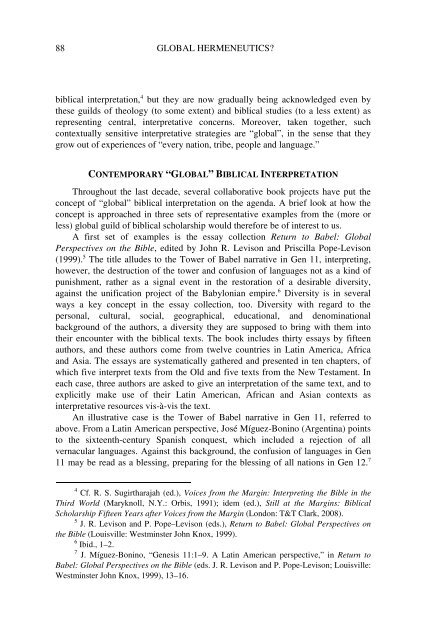Global Hermeneutics? - International Voices in Biblical Studies ...
Global Hermeneutics? - International Voices in Biblical Studies ...
Global Hermeneutics? - International Voices in Biblical Studies ...
You also want an ePaper? Increase the reach of your titles
YUMPU automatically turns print PDFs into web optimized ePapers that Google loves.
88 GLOBAL HERMENEUTICS?<br />
biblical <strong>in</strong>terpretation, 4 but they are now gradually be<strong>in</strong>g acknowledged even by<br />
these guilds of theology (to some extent) and biblical studies (to a less extent) as<br />
represent<strong>in</strong>g central, <strong>in</strong>terpretative concerns. Moreover, taken together, such<br />
contextually sensitive <strong>in</strong>terpretative strategies are “global”, <strong>in</strong> the sense that they<br />
grow out of experiences of “every nation, tribe, people and language.”<br />
CONTEMPORARY “GLOBAL” BIBLICAL INTERPRETATION<br />
Throughout the last decade, several collaborative book projects have put the<br />
concept of “global” biblical <strong>in</strong>terpretation on the agenda. A brief look at how the<br />
concept is approached <strong>in</strong> three sets of representative examples from the (more or<br />
less) global guild of biblical scholarship would therefore be of <strong>in</strong>terest to us.<br />
A first set of examples is the essay collection Return to Babel: <strong>Global</strong><br />
Perspectives on the Bible, edited by John R. Levison and Priscilla Pope-Levison<br />
(1999). 5 The title alludes to the Tower of Babel narrative <strong>in</strong> Gen 11, <strong>in</strong>terpret<strong>in</strong>g,<br />
however, the destruction of the tower and confusion of languages not as a k<strong>in</strong>d of<br />
punishment, rather as a signal event <strong>in</strong> the restoration of a desirable diversity,<br />
aga<strong>in</strong>st the unification project of the Babylonian empire. 6 Diversity is <strong>in</strong> several<br />
ways a key concept <strong>in</strong> the essay collection, too. Diversity with regard to the<br />
personal, cultural, social, geographical, educational, and denom<strong>in</strong>ational<br />
background of the authors, a diversity they are supposed to br<strong>in</strong>g with them <strong>in</strong>to<br />
their encounter with the biblical texts. The book <strong>in</strong>cludes thirty essays by fifteen<br />
authors, and these authors come from twelve countries <strong>in</strong> Lat<strong>in</strong> America, Africa<br />
and Asia. The essays are systematically gathered and presented <strong>in</strong> ten chapters, of<br />
which five <strong>in</strong>terpret texts from the Old and five texts from the New Testament. In<br />
each case, three authors are asked to give an <strong>in</strong>terpretation of the same text, and to<br />
explicitly make use of their Lat<strong>in</strong> American, African and Asian contexts as<br />
<strong>in</strong>terpretative resources vis-à-vis the text.<br />
An illustrative case is the Tower of Babel narrative <strong>in</strong> Gen 11, referred to<br />
above. From a Lat<strong>in</strong> American perspective, José Míguez-Bon<strong>in</strong>o (Argent<strong>in</strong>a) po<strong>in</strong>ts<br />
to the sixteenth-century Spanish conquest, which <strong>in</strong>cluded a rejection of all<br />
vernacular languages. Aga<strong>in</strong>st this background, the confusion of languages <strong>in</strong> Gen<br />
11 may be read as a bless<strong>in</strong>g, prepar<strong>in</strong>g for the bless<strong>in</strong>g of all nations <strong>in</strong> Gen 12. 7<br />
4 Cf. R. S. Sugirtharajah (ed.), <strong>Voices</strong> from the Marg<strong>in</strong>: Interpret<strong>in</strong>g the Bible <strong>in</strong> the<br />
Third World (Maryknoll, N.Y.: Orbis, 1991); idem (ed.), Still at the Marg<strong>in</strong>s: <strong>Biblical</strong><br />
Scholarship Fifteen Years after <strong>Voices</strong> from the Marg<strong>in</strong> (London: T&T Clark, 2008).<br />
5 J. R. Levison and P. Pope–Levison (eds.), Return to Babel: <strong>Global</strong> Perspectives on<br />
the Bible (Louisville: Westm<strong>in</strong>ster John Knox, 1999).<br />
6 Ibid., 1–2.<br />
7 J. Míguez-Bon<strong>in</strong>o, “Genesis 11:1–9. A Lat<strong>in</strong> American perspective,” <strong>in</strong> Return to<br />
Babel: <strong>Global</strong> Perspectives on the Bible (eds. J. R. Levison and P. Pope-Levison; Louisville:<br />
Westm<strong>in</strong>ster John Knox, 1999), 13–16.




